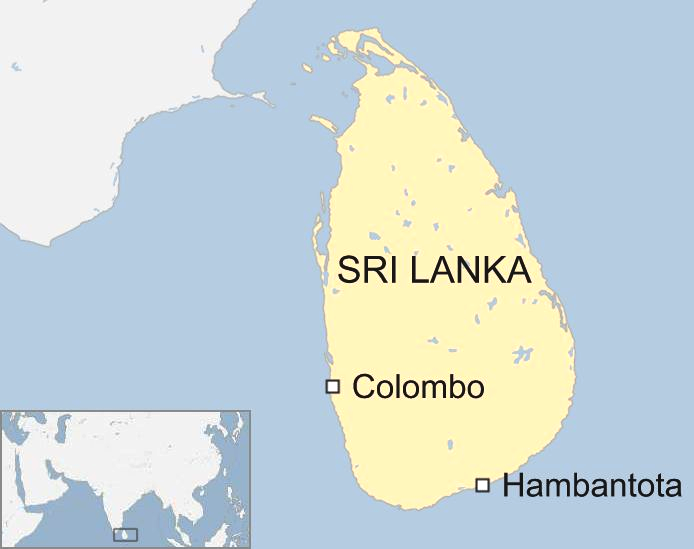Chinese Vessel in Sri Lanka | 17 Aug 2022
For Prelims: Yuang Wang Vessel, Indian & Sri Lanka Relations
For Mains: Effect of Policies & Politics of Countries on India's Interests, India and its Neighbourhood, India-Sri Lanka Relations
Why in News?
Recently, China’s satellite tracking vessel Yuan Wang 5 has arrived at Sri Lanka’s southern Hambantota Port, despite India and the U.S. voicing concern with Colombo over the military ship’s visit.
What do we know about Yuan Wang 5 & Hambantota Port?
- Yuan Wang 5:
- It is a third-generation vessel of the Yuan Wang series that entered service in 2007.
- This series of ships include "space tracking ships involved in supporting the manned space programme".
- It has the ability to track satellites and intercontinental missiles.
- Hambantota Port:
- Hambantota International Port Group is a Public Private Partnership and a Strategic Development Project between the Government of Sri Lanka and China Merchants Port Holdings (CMPort).
- This port was given to China by Sri Lanka on a 99-year lease after Sri Lanka failed to repay Chinese loans.
- It is seen as a case of Chinese "debt trap" Diplomacy.
Why is China’s Presence in Sri Lanka a Concern for India?
- Recently, China's presence in Sri Lanka has increased on a large scale.
- China is the largest bilateral creditor to Sri Lanka.
- Its loans to the Sri Lankan public sector amount to 15% of the central government’s external debt.
- Sri Lanka heavily relies on Chinese credit to address its foreign debt burden.
- China extended about USD 2.8 billion to Sri Lanka soon after the pandemic hit but has not stepped in much in 2022, even as the island’s economy collapsed rapidly.
- China has invested about USD 12 billion in Sri Lanka’s infrastructure projects between 2006-19.
- China enjoys friendlier waters in South Asia and the Indian Ocean than it does in Southeast Asia and the Pacific.
- China faces opposition from Taiwan, territorial disputes in the South China Sea and East Asia, and myriad frictions with the US and Australia.
- China is the largest bilateral creditor to Sri Lanka.
- India’s Concern due to China’s Presence:
- Sri Lanka has decided to establish a Special Economic Zone around the Colombo port city and a new economic commission, to be funded by China.
- The Colombo port handles 60% of India’s trans-shipment cargo.
- Leasing of Hambantota and the Colombo Port City project makes it almost certain for the Chinese navy to have a permanent presence in the Indian Ocean which will be worrisome for India’s national security.
- This Chinese strategy to encircle India is referred to as the Strings of Pearls Strategy.
- Other South Asian nations like Bangladesh, Nepal and the Maldives have also been turning to China to finance large-scale infrastructure projects.
- Sri Lanka has decided to establish a Special Economic Zone around the Colombo port city and a new economic commission, to be funded by China.
What should be India’s Approach Moving Forward?
- Preserving Strategic Interests:
- Nurturing the Neighbourhood First policy with Sri Lanka is important for India to preserve its strategic interests in the Indian Ocean region.
- Taking Advantage of Regional Platforms:
- Platforms like the BIMSTEC, SAARC, SAGAR and the IORA could be leveraged to foster cooperation in fields like technology-driven agriculture, marine sector development, IT & communication infrastructure etc.
- Restraining Chinese Expansion:
- India will need to continue to work on the Kankesanturai port in Jaffna and the oil tank farm project in Trincomalee to ensure that China does not make any further inroads in Sri Lanka.
- Both countries can also cooperate on enhancing private sector investments to create economic resilience.
- Leveraging India’s Soft Power:
- In the technology sector, India can create job opportunities in Sri Lanka by expanding the presence of its IT companies.
- These organizations can create thousands of direct and indirect jobs and boost the island nation’s service economy.
UPSC Civil Services Examination, Previous Year Questions (PYQs)
Prelims
Q. Consider the following statements: (2020)
- The value of Indo-Sri Lanka trade has consistently increased in the last decade.
- “Textile and textile articles” constitute an important item of trade between India and Bangladesh.
- In the last five years, Nepal has been the largest trading partner of India in South Asia.
Which of the statements given above is/are correct?
(a) 1 and 2 only
(b) 2 only
(c) 3 only
(d) 1, 2 and 3
Ans: (b)
Exp:
- As per data from the Department of Commerce, Indo- Sri Lanka bilateral trade value for a decade (2007 to 2016) was 3.0, 3.4, 2.1, 3.8, 5.2, 4.5, 5.3, 7.0, 6.3, 4.8 (in billion USD). It reflects continuous fluctuation in the trend of trade value. There has been an overall increase but the same cannot be said as consistent rise in trade value. Hence statement 1 is not correct.
- Bangladesh has been a major textile trading partner for India, with a share of more than 5% in exports and over 7% in imports. While annual textile exports to Bangladesh averages $2,000 million, imports are worth $400 (Year: 2016-17).
- The major items of exports are fibre and yarn of cotton, man-made staple fibres and an-made filaments while major import items include apparel and clothing, fabric and other made up textile articles. Hence, statement 2 is correct.
- According to the data, in 2016-17, Bangladesh is India’s largest trading partner in South Asia, followed by Nepal, Sri Lanka, Pakistan, Bhutan, Afghanistan and Maldives. The level of Indian exports also follows the same order. Hence, statement 3 is not correct.
- Therefore, option (b) is the correct answer.
Mains
Q. What do you understand by ‘The String of Pearls’? How does it impact India? Briefly outline the steps taken by India to counter this. (2013)
Q. In respect of India-Sri Lanka relations, discuss how domestic factors influence foreign policy. (2013)

